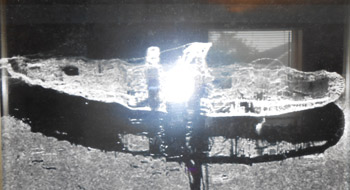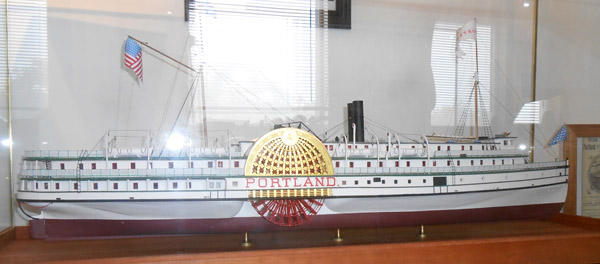The Great Gale of 1898 and the Sinking of the Steamer Portland
by Tom Seymour

A side scan sonar image of the Portland. According to Bachelder and Smith, authors of Four Short Blasts, the Portland wreck is roughly 20 miles north of Provincetown, MA in water between 200 and 400 feet deep, too deep for researchers to dive. They used a submersible machine instead. The exact location is undisclosed to keep treasure hunters away. Tom Seymour photo
Many people have seen the movie “The Perfect Storm” and some may have even read the Sebastian Junger book upon which the movie was based.
“The Perfect Storm” detailed the meeting of three, separate storms off the New England coast in October 1991. The Andrea Gail, a 72-foot swordfishing vessel, was lost in that storm somewhere off the Nova Scotia coast on October 28. Some remains of the vessel made it ashore; these included a propane tank, fuel drums and some radio equipment.
The storm that claimed the Andrea Gail was said to be a “storm of the century,” and so it was. Conditions came together in such a way as to create winds and waves against which no ship could contend. Such storms (not including hurricanes) only strike New England about once every 100 years. And as it turns out, nearly 100 years prior, another perfect storm struck New England, this one doing far more damage to property and ships at sea and claiming many more human lives.
The Great Gale of 1898, sometimes known as the “Portland Gale” or the “Portland Breeze,” according to Captain Jim Sharp of the Sail, Power & Steam Museum in Rockland, was responsible for the loss of 400 vessels, including the steamship Portland. This was a natural disaster of epic proportions.
In addition to the lost vessels, an exact count of lives lost is impossible. It is thought the steamer Portland went down with upward of 200 souls on board, but that is only an educated guess, since the ship’s passenger list was never recovered. Lots of other bits and pieces of the Portland, more than ample to document the identity of the vessel they were once part of, were found, however, strewn along the beach.
Weather Reports
While the science of meteorology as we know it was in its infancy, weather reports were available and sent around the nation via telegraph. So the arrival of the great storm was not a surprise. Unfortunately, many captains and shipping companies vastly underestimated the storm’s murderous potential.
Close Call
Despite the great number of vessels and lives lost, many mariners did heed the weather forecasters warning and either did not sail at all, or set out and immediately turned back. Among these was the sailing vessel Lavinia Snow.
Just outside Boston Harbor, a steam tug was heading in ahead of the storm. The captain of the tug saw two vessels and, hailing the first one, trumpeted, “Captain, would you like a tow in?” The winds had begun to whip up just minutes before, and it was evident things would get worse before they got better. “No thanks, Captain,” the first vessel’s captain replied. “I think I can make it fine.”
So the tug continued on toward the harbor and then hailed the Lavinia Snow. The Snow’s captain, alarmed by the ever-increasing winds and high seas, gladly accepted a tow into the harbor. But it was nearly too late. After the tug’s crew had secured a line to the Lavinia Snow, the wind caught her sideways and the tug had to apply all the steam it possessed in order to proceed at even a snail’s pace. But eventually the tug and its charge were safely inside the protected harbor. Minutes more, and things would have been radically different.
As it was, the vessel that declined a tow was suspected lost at sea during the gale. The Lavinia Snow, built and owned by the Snow Shipyard in Rockland, Maine, escaped disaster by the narrowest margin. The same could not be said for numerous other Rockland vessels. Many of these were washed ashore and beaten by huge waves. Among vessels affected by the gale were the Albert L. Butler, Henry R. Tilton, Juanita, Stetson, Curtis H. Perry and the Katahdin.
Wikipedia lists the following, which somewhat conflicts with the Batchelder and Smith account: In 2008, five Massachusetts scuba divers became the first to reach the steamship, also known as the “Titanic of New England.” The divers spoke about their three successful dives to 460 feet, relating that they found no human remains. They indicated that they did not explore below the deck because of the danger. Their dives, 10–15 minutes in length, were used in exploring the site before returning to the surface. The divers “were unable to retrieve artifacts” due to rules in place at Stellwagen Bank National Marine Sanctuary. Tom Seymour photo
Steamship Portland
The steamship Portland was undoubtedly the most noteworthy victim of the gale. The vessel’s captain, Captain Hollis Blanchard, made the decision to sail that fateful evening, but the reasons behind his decision remain unclear. When news first hit of the Portland’s loss, the New England news media criticized the captain as foolhardy and headstrong. It was even insinuated that Captain Blanchard went against orders. But later, there was word from Captain Blanchard’s son, who was on the Portland that evening trying to convince his father to refrain from sailing. The son said Captain Blanchard remarked that, despite the impending storm, he had his orders to sail and so he must sail.
So sail the captain did, and what exactly happened in those hours after leaving Boston, heading for Portland, Maine, is unclear. The question of how far the Portland made it before being pushed about by the wind or turning about on her own is widely debated.
The Portland was sighted at various points during the night, by those watching from lighthouses and from other vessels at sea also fighting the storm. One onshore observer reported watching Portland as she sailed out of Boston Harbor.
Captain Jason Collins, the captain of the Kennebec, another steamship, noted watching the Portland on her way out of the harbor. Captain Collins is said to have blown the ship’s whistle at the Portland as a warning to turn back, but the Portland did not respond. The Kennebec had left Boston Harbor ahead of the Portland, but taking conditions into account, Captain Collins decided to turn about and return to Boston Harbor.
Another passenger steamer from Maine, the Mt. Desert, also reported seeing the Portland pass by. And the keeper of the light at Deer Island outside Boston Harbor noted watching the Portland steam past.
Numerous other vessels reported seeing the Portland that night.
The last recorded sighting of the Portland was by Captain Lynes B. Hathaway, who was visiting the light station on Thatcher’s Island. Captain Hathaway said the Portland passed within about 500 feet of the island’s south shore. This placed the Portland somewhere between the island and a dangerous reef about 1,000 yards out from the island.
Thatcher’s Island sits about one-half mile east of Cape Ann, Massachusetts. Captain Hathaway did not notice the Portland was in trouble or even in a bad way. But his sighting is the last known of the doomed sidewheel steamer.
What eventually happened to the Portland, the details of how she met her end, is and will remain a mystery. Huge waves, no doubt, tore off her superstructure and swamped the vessel, sending her and those aboard to the bottom of the sea. The terror experienced by those aboard can only be imagined.
Wreck Located
After the gale abated, bits and pieces of the Portland made their way to shore, as did at least some bodies of the passengers and crew. Enough came ashore bearing the name “Portland” to prove beyond a doubt the steamer had sunk in the gale.
For years after, the location of the Portland’s final resting place was a topic of debate. Some indications had her in one place and some in another. But in the 1970s, well-equipped searchers belonging to the Historical Maritime Group of New England, based in Bourne, Massachusetts, began hunting for the Portland using modern, side-scan sonar. This began a new and independent search for the Portland’s watery grave. The search began in the waters off Provincetown.
The searchers did not locate anything to indicate the Portland presence here. Some years passed, and on-and-off searches continued with no positive results. Then, in April of 1989, the team, this time further out to sea at Stellwagen Bank, found something they were convinced was the hull of the Portland. They held a news conference, announcing the find.
However, photographic evidence was lacking and this lack of conclusive evidence kept the question alive in some minds as to whether or not the wreck was truly that of the Portland.
In 2002, the Stellwagen Bank National Marine Sanctuary, working with University of Connecticut, positively confirmed the wreck as that of the Portland. Close-up images are now available and the Portland’s wreck is considered the best-preserved of its kind.
Thanks to the Sail, Power & Steam Museum in Rockland, Maine, for assistance in gathering data and providing photographs for this article.

